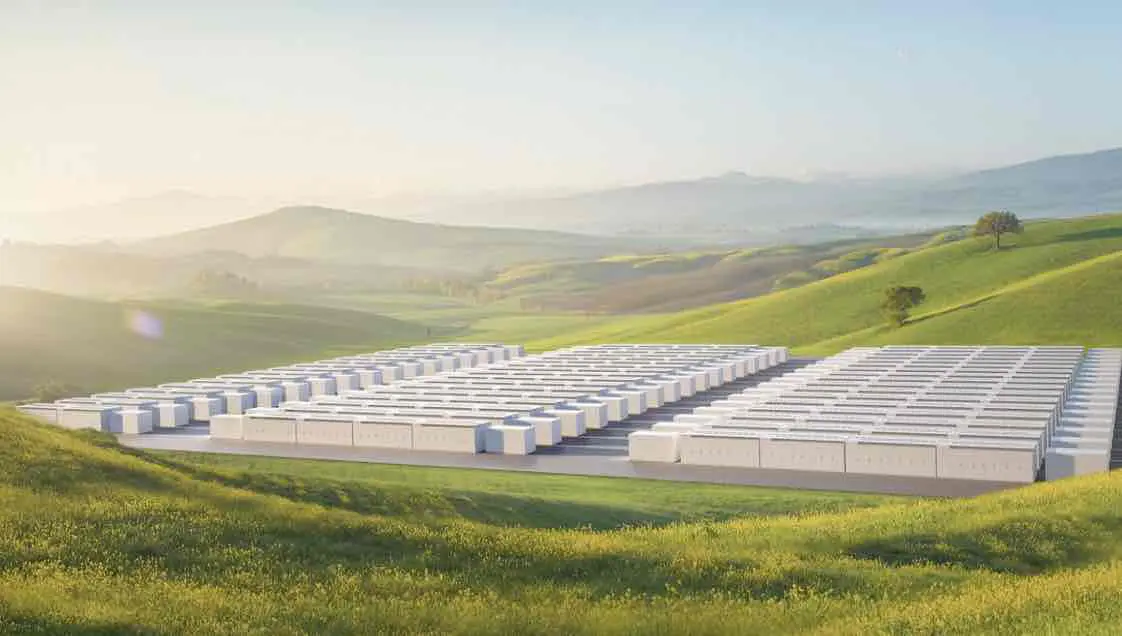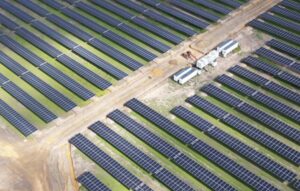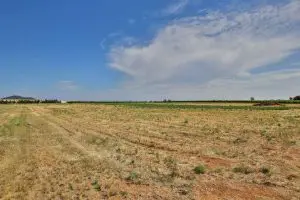The three newly announced giant battery projects in NSW will be enough to fill the reliability gap created by the planned closure of the country’s biggest coal plant in 2025, but the federal government’s Capacity Investment Scheme will need to be boosted if it to meet the country’s 2030 renewable energy target.
These are the major takeaways of a new analysis from the Institute of Energy Economics and Financial Analysis (IEEFA) that analyses the impact of the government’s first tender under the Capacity Investment Scheme, and its plans to expand it to deliver 32GW of new capacity by 2030.
IEEFA says that first tender, held in concert with NSW and expanded significantly by the intervention of the federal government , will be sufficient – along with new wind and solar projects – to fill the gap created by the planned closure of Eraring in August, 2025.
Those new battery projects included the Orana battery (artist’s image above), and the Liddell and Smithfield batteries, totalling 980 MW and 2790 MWh of storage, along with 95 MW of demand response capacity.
IEEFA says that if Eraring is to be extended, as is being discussed by the NSW government with the Eraring owners Origin Energy, it will simply undermine the financial viability of the remaining coal generators, and possibly lead to their early closure.
“Essentially, propping up Eraring is like robbing Peter to pay Paul, with other coal power stations left vulnerable,” says lead IEEFA electricity analyst Johanna Bowyer.
One of the most impacted generators would be Vales Point, which was recently bought by a Czech outfit and originally signalled it wanted to delay its planned closure from 2029 to 2032. But Bowyer says Vales Point’s capacity factor could drop as low as 9% if Eraring’s closure was delayed.
IEEFA’s assessment of the newly expanded CIS – now seeking 9 GW of storage (average four hours) and now including 23 GW of wind and solar capacity – is similar to others.
IEEFA’s Bowyer, like the analysts at Rystad Energy, says that the plans outlined by federal energy minister Chris Bowen will get renewables to around 70 per cent of the market, still short of the 82 per cent renewable share that is the current government’s target.
Bowyer says that another 13GW of new wind and solar capacity will be required to fill the gap, which means that state-based targets will be important.
She notes it is not clear if the NSW government’s existing roadmap, which aims for 12GW of new capacity by 2030 through a series of tenders already underway, will continue and be additional to the federal government’s CIS, or not.
“Our analysis (with the help of ITP Renewables’ openCEM modelling tool) shows that the preferred utility-scale renewable generation build is wind energy,” Bowyer notes.
“Daytime demand is increasingly being satisfied by customers investing in their own rooftop solar, so utility-scale investments are heavily concentrated in wind, which can also help meet night-time demand.”
Bowyer says that the Australian Energy Market Operator’s data would suggest it believes only an extra 7 GW of additional large scale renewables will e required on top of the 23 GW to hit the 82 per cent goal. She notes that the latest version of the Integrated System Plan, due on Friday, may provide a more up to date view.
“When large power stations exit the market, there is usually an uptick in prices,” Bowyer writes.
“This could happen post the Eraring closure. Building new capacity can help contain price rises, as can demand-side measures such as energy efficiency, demand flexibility and distributed energy resources (DER) uptake.
“What this modelling illustrates is that no matter which way we cut this, there isn’t enough space left in the market for Eraring after 2025. It just isn’t needed.
“Given that the first CIS auction was overwhelmed with bids, if the NSW Government wanted some additional insurance to safeguard reliability, it would be better off running another auction as soon as possible.
“At the same time, it should also look at how to accelerate and expand mechanisms to improve energy efficiency and reduce peak demand.”










